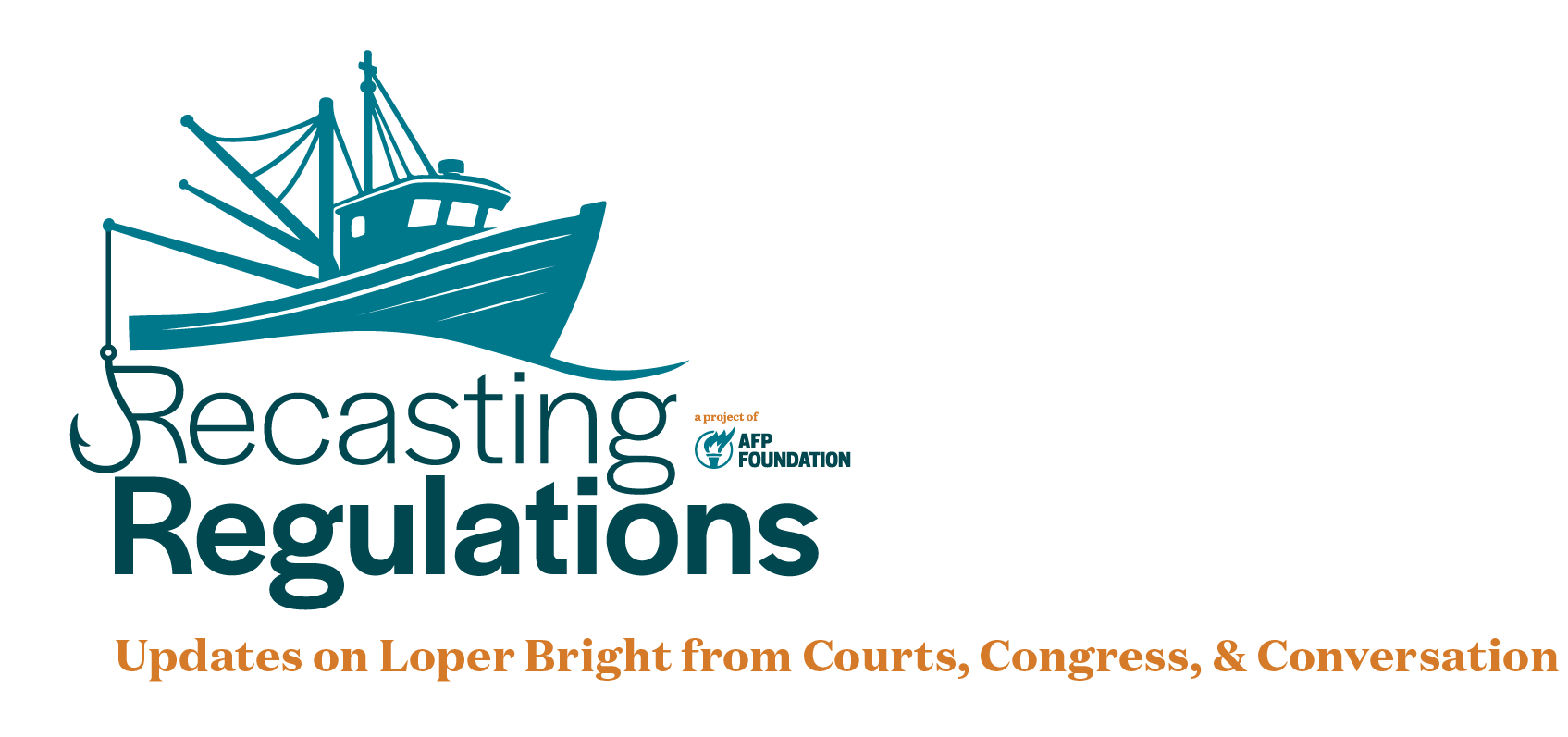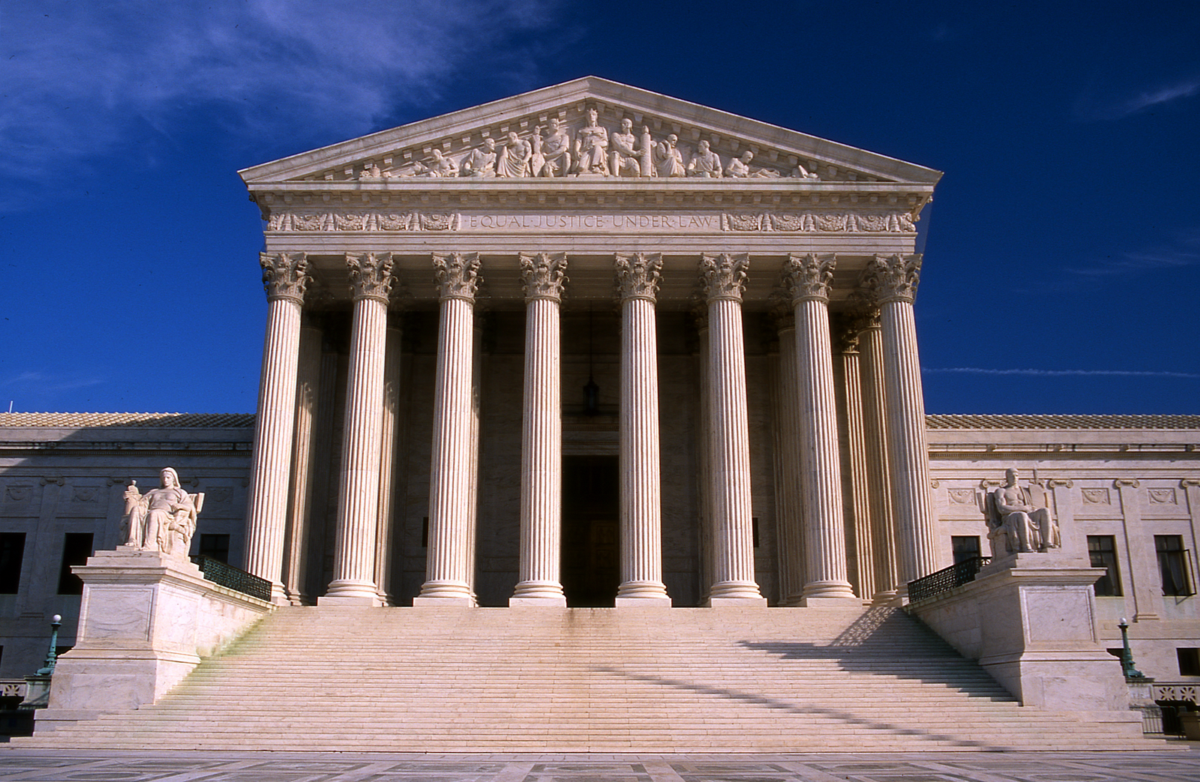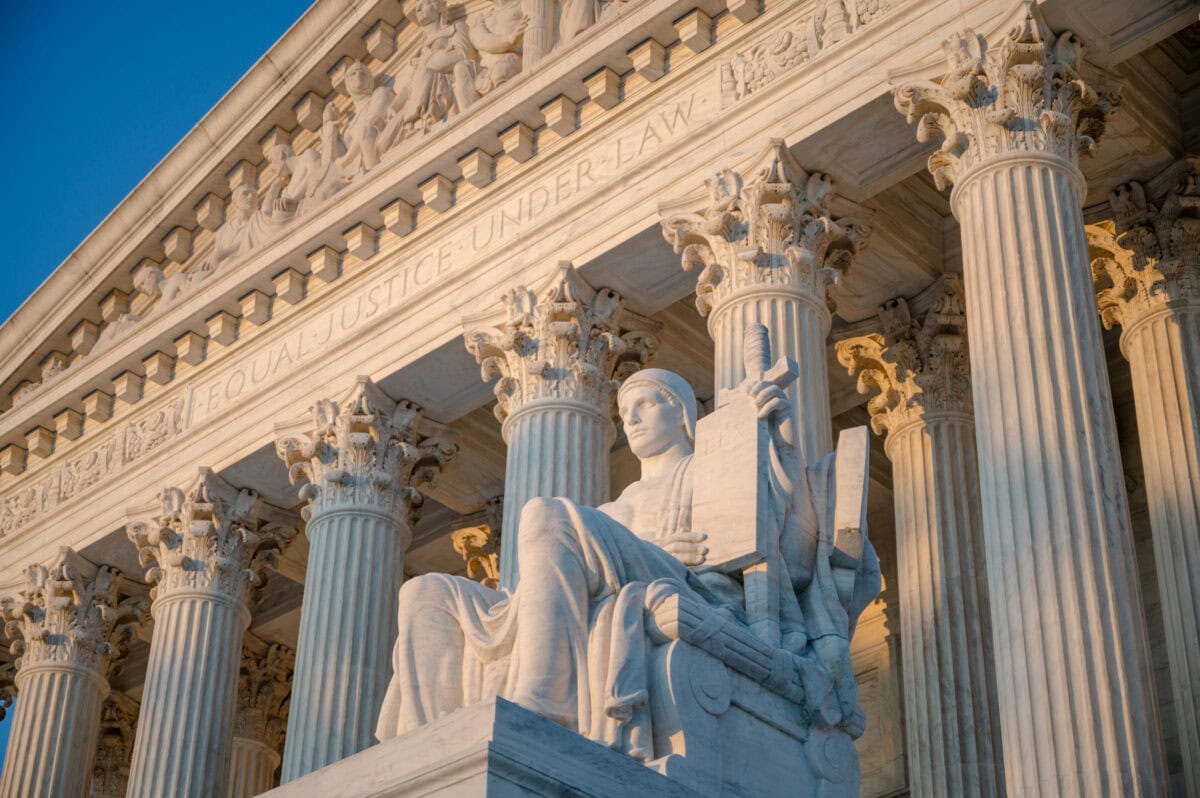
Subscribe to Recasting Regulations to Sign up for Loper Bright Updates.
"*" indicates required fields
At SCOTUSblog, Abbe R. Gluck writes about Kennedy v. Braidwood Management, and ” the broader question of how the court will grapple with questions of expertise in the wake of its 2024 decision overruling Chevron v. Natural Resources Defense Council, the key agency-deference case of the modern era.”
Finally, for good measure, the opinion concludes with a touch of implicit Skidmore deference, the pre-Chevron deference regime under which courts give weight to agency interpretations, especially consistent ones, but only to the extent they have the “power to persuade.” Citing Loper Bright Enterprises v. Raimondo, the decision that overruled Chevron, Justice Kavanaugh noted, “the Executive Branch’s actions for the last 26 years … have reflected that straightforward interpretation of the statute—without any apparent objection from Congress … to ‘convene’ the Task Force to include the power to appoint the Task Force members. That considered and consistent Executive Branch practice … buttresses the ordinary meaning and natural interpretation of the term ‘convene’ in the statute.”
This methodology thus follows a trend that has emerged in several other cases this term as the court resets after Loper Bright: The court now insists, in what many view as a revival of Skidmore, that it is construing the statute independently but looks to a consistent agency interpretation as evidence of the correctness of that interpretation.
Bloomberg Law’s Robert Iafolla writes about how “circuit courts have started going in different directions on the level of deference judges should grant agencies.”
Federal appeals courts are still figuring out how much weight to give to agencies’ views of their legal authority, a year after the US Supreme Court said judges must interpret relevant laws.
…
“The lower courts aren’t certain what to do with Skidmore after Loper Bright,” said Kristin Hickman, an administrative law professor at the University of Minnesota. “What we’re seeing reflected in the Ninth Circuit and Fifth Circuit is emblematic of that uncertainty.”
…
Loper Bright instructed courts to treat Skidmore as an optional canon of construction, said Eric Bolinder, an administrative law professor at Liberty University. That’s how the justices themselves used Skidmore—without citing it—in a March decision upholding regulations on ghost guns, he said.
Harvard Law School’s Matthew Stephenson recently published “The Gray Area: Finding Implicit Delegation to Agencies After Loper Bright.” From the abstract:
This Article argues that the canonical pre-Chevron cases Gray v. Powell and NLRB v. Hearst Publications, together with their antecedents and progeny, provide a useful framework for distinguishing those interpretive questions on which courts ought to find implicit delegations to agencies from those issues that are for the courts to decide without deference. The Gray doctrine establishes a presumption that, when a statute empowers an agency to take some authoritative action which necessarily involves the application of an imprecise statutory term to particular situations, the statute should be read as implicitly delegating to the agency the authority to make the necessary line-drawing decisions. At the same time, the Gray doctrine does not call for judicial deference to an agency’s views on the resolution of interpretive questions that can be answered through abstract textual or structural analysis.
Courts can and should incorporate the Gray doctrine into the implicit delegation prong of the Loper Bright framework. Doing so would be both legal—consistent with the Administrative Procedure Act (APA) as interpreted by Loper Bright—and desirable. The Gray doctrine provides a structured, workable method—one well-grounded in decades of pre-Chevron case law—for deciding when a finding of implicit delegation is appropriate. Integrating Gray into Loper Bright would achieve a more appropriate allocation of authority between the judicial and executive branches than would alternative and more restrictive approaches to Loper Bright’s implicit delegation prong.
This past Term, the Supreme Court cited Loper Bright in several statutory interpretation decisions, including Seven County Infrastructure Coalition v. Eagle County, Bondi v. VanDerStock, McLaughlin Chiropractic Assocs., Inc. v. McKesson Corp., and City and County of San Francisco v. EPA. Loper Bright surfaced again on the last day of the Term in FCC v. Consumers’ Research, a case involving a nondelegation and private nondelegation challenge to the Universal Service Fund—a telecommunications social welfare program funded by a charge set by unelected administrators at the FCC (who, in turn, punted that task to a private corporation made up of self-interested industry insiders).
Consumers’ Research presented the Court with an opportunity to reinvigorate the nondelegation doctrine by enforcing Article I’s bar against Congress transferring its exclusive legislative power to other entities. The Court did not take that path. Instead, in a 6–3 decision, the Court declined to revisit the “intelligible principle” regime, rejecting Consumers’ Research’s nondelegation and private nondelegation challenges, as well as the Fifth Circuit’s “combination theory” of unconstitutionality.
Justice Kagan’s and Kavanaugh on Loper
Writing for the six-Justice majority, Justice Kagan cited Loper Bright in the course of construing the statute to grant the FCC far more limited powers than under the dissent’s (and Fifth Circuit’s) interpretation—a move that diminishes constitutional concerns. Justice Kagan suggested that at oral argument the Solicitor General had taken the position that the statute imposed certain limits on the agency’s powers but emphasized, quoting Loper Bright, that “[i]n any event, and yet more important, we must ‘exercise [our] independent judgment in deciding’ what power Congress has conferred”—a key overarching point of Loper Bright. In a footnote, the dissent echoed this core point in Loper Bright but parted ways on its application in this case to the Solicitor’s statements.
Justice Kavanaugh’s solo concurrence also cites Loper Bright, offering some insight into its broader significance and impact. As Professor Josh Blackman has observed, Justice Kavanaugh’sthoughtful Consumers’ Research concurrence is interesting for a number of reasons. Justice Kavanaugh suggests that, in his view, “[m]any broader structural concerns about expansive delegations” of power by Congress to the Executive branch “have been substantially mitigated” by the Supreme “Court’s rejection of so-called Chevron deference” in Loper Bright, as well as the Court’s use of the “major questions canon.” And citing passages in Loper discussing courts’ duty under the Administrative Procedure Act to independently interpret statutes and role in policing delegations of discretion to the Executive, Justice Kavanaugh notes that while intelligible-principle test doesn’t do much to stop Congress from delegating power to the Executive, “the President’s actions when implementing legislation are constrained—namely, by the scope of Congress’s authorization and by any restrictions set forth in that statutory text.” Justice Kavanaugh also suggested that broad delegations to “independent” agencies raise greater constitutional concerns, to the extent those administrative bodies can constitutionally exist.
Will Consumers Research “Stand the Test of Time?”
In his dissent in Consumers’ Research, Justice Gorsuch, joined by Justices Thomas and Alito, cites his concurring opinion in Loper Bright, which gives a thoughtful, scholarly exposition of his views on stare decisis and why courts shouldn’t overread stray remarks and dicta as holdings. Justice Gorsuch wrote that “things could be worse. Because today’s misadventure ‘sits unmoored from surrounding law,’ I have reason to hope its approach will not stand the test of time.” This reminds that the now-overruled Chevron doctrine requiring courts to grant “deference” to agency interpretations of ambiguous statutes was built on an overreading of stray dicta in its namesake Chevron v. NRDC. And at the risk of being an optimist, one wonders whether Consumers’ Research may end up being something of a one-off that we should not overread. Time will tell. But what is clear at Loper Bright’s one-year mark is that while the result in Consumers’ Research was disappointing to many, Loper Bright is a landmark victory reaffirming that it is up to the Judiciary—and not the Executive—to say what the law is and independently determine the metes and bounds of the discretion and powers Congress has granted the Executive. While Loper Bright is not a panacea for the ill effects of the current distortion in our system of separated powers and federalism, it is an important, much-needed step in the right direction that, to borrow Justice Kavanaugh’s language, “mitigates” some of those problems.
Two commenters from the NYU School of Law’s Institute for Policy Integrity have a piece on the Yale Notice & Comment blog challenging the Trump Administration’s invocation of Loper Bright as a nondiscretionary basis to rescind the existing regulatory definition of “harm” as it applies to the Endangered Species Act.
Jack Jones and Max Sarinsky write:
The agencies seek to rescind the definitions of “harm” in the Endangered Species Act regulations, based on their conclusion that the current definitions “do not match the single, best reading of the statute,” per Loper Bright. But as the notice acknowledges, the Supreme Court upheld the current regulatory definitions in Babbitt v. Sweet Home Chapter of Communities for a Great Oregon. And even though Loper Bright emphasized that cases like Sweet Home remain good law, the agencies claim that the rescission is “compelled” by law because they have concluded that the definitions do not reflect the best reading of the statute. The agencies then go further, asserting that the rescission is thus a “nondiscretionary action,” meaning they “do[] not have authority” to consider otherwise relevant policy or factual issues such as the repeal’s environmental effects.
But the agencies’ conclusion misunderstands Loper Bright’s discussion of statutory stare decisis. Because the current regulatory definitions were previously upheld in Sweet Home, they remain good law after Loper Bright. The agencies could choose to maintain them and are not legally compelled to rescind them even if, as the agencies claim, they are inconsistent with the statute’s best reading. Accordingly, the agencies’ decision to rescind the regulations is voluntary, not “nondiscretionary”—and the agencies therefore do need to rationally consider relevant policy and factual issues in order to satisfy the requirements of reasoned decisionmaking.
Americans for Prosperity Foundation filed a regulatory comment supporting the rescission. And Recasting Regulations has also featured the Jonathan Nash article on Chevron and stare decisis upon which Jones and Sarinsky rely.
Loper Bright Enterprises v. Raimondo’s Legacy Empowers Courts, Congress to Reclaim Proper Constitutional Roles
Washington, DC, June 27, 2025 — Tomorrow marks the first anniversary of the Supreme Court’s landmark ruling in Loper Bright Enterprises v. Raimondo, a transformative decision that ended four decades of Chevron deference. By restoring to courts the duty to interpret the law and provide an independent judgment as to its best meaning, the Supreme Court helped realign the proper balance of power between Congress, the administrative state, and the federal judiciary.
“The Loper Bright decision changed the landscape of administrative law. It will be remembered as a watershed moment in Supreme Court jurisprudence,” said Ryan P. Mulvey, senior policy counsel at Americans for Prosperity Foundation and senior counsel at Cause of Action Institute. “The Court was right to reiterate the Founders’ vision of judges—not bureaucrats—telling us what the law means. The end of Chevron deference is an important step to helping us keep regulatory agencies in check and within the bounds of the authority given to them by Congress.”
Over the past year, Loper Bright has influenced developments across the federal government. Courts at the federal and state levels have cited the precedent in nearly 1,000 cases. In some of the more impactful decisions, the new Loper Bright standard was used to invalidated the Federal Communications Commission’s net neutrality rules, and to reject the Food and Drug Administration’s novel attempt to regulate laboratory testing services as manufactured “devices.”
Loper Bright has played a prominent role in the Trump Administration’s deregulatory agenda, too. The Environmental Protection Agency pointed to Loper Bright as the basis for its reconsideration of a controversial “endangerment finding” on greenhouse gases, and the Department of the Interior is using it to rescind a long-contested regulatory definition of “harm” under the Endangered Species Act. President Trump even identified Loper Bright as one the principal bases for the DOGE deregulatory initiative kicked off by Executive Order 14219.
And the end of Chevron deference has not escaped the attention of Congress either. The “Post-Chevron Working Group,” led by Senator Eric Schmitt, published a lengthy report earlier this month detailing the importance of Loper Bright and how it can be leveraged by federal legislators to reclaim their Article I authority. Former Senators Heitkamp and Martinez led similar efforts at the Bipartisan Policy Center, recommending practical solutions for a post-Chevron Congress.
Despite these impressive developments, it is vital to remember the Loper Bright case was always about Atlantic herring fishermen threatened by an unlawful regulatory requirement that could force them to surrender 20 percent of their earnings to pay for at-sea monitors to ride their boats and watch them fish. The government relied on Chevron deference to justify its controversial monitoring rule. Yet, with Chevron overruled, the saga of the fishermen continues, and the fate of the industry-funding requirement hangs in the balance. The D.C. Circuit considered the fishermen’s supplemental briefs and heard oral argument on remand last fall, and an opinion is expected in the near future. “By returning interpretive power to courts, Loper Bright reaffirmed the separation of powers and the rule of law,” said Mulvey. “Now, the real test is ensuring the fishermen aren’t left paying for regulatory programs with no firm statutory basis.”
First, we have Bernard W. Bell from the Rutgers Law School – Newark in the Seton Hall Law Review on “Loper Bright: Resurrecting Skidmore in a New Era.” Some excerpts from the abstract:
In Loper Bright v. Raimondo (2024), the Supreme Court abandoned Chevron deference to agency statutory interpretations, resurrecting the Skidmore “persuasive” deference regime. This article offers three observations.
First, the judicial context has changed since Chevron’s adoption, such that the new” Skidmore deference will produce quite different results than the old.
…
Second, the “major questions doctrine” will make inroads on Skidmore deference when the text favors agencies. The Court’s rejection of Chevron (and reinstatement of Skidmore), was based on the concept that “the law” never simply “runs out.” That proposition directly contradicts the premise of the major questions doctrine, that in some instances the law does indeed “run out” and Congress must create “new” law to directly address crucial issues.
…
Third, the article explores the treatment of Chevron-based interpretive precedents in this second Skidmore era. In Loper Bright, the Court adopted an apparently categorical rule, that Chevron-based precedents remain “good law.” In so choosing, the Court might have sought to avoid the failures of its more nuanced, and ultimately quite unsatisfactory, Brand X approach to Skidmore-based precedent in a Chevron world. However, the Loper Bright categorical rule is less categorical than it seems.
Next, we have Matthew Mulholland from the Lincoln Memorial University Duncan School of Law with “Beyond Saving Ink: How the Current Court Finds Meaning in Statutory Variations Post-Loper Bright.” From the abstract:
This case comment analyzes the Supreme Court’s decision in San Francisco v. EPA, a pivotal moment illustrating the Court’s renewed emphasis on strict statutory interpretation and finding significance in subtle textual variations to limit agency power in the post-Loper Bright era. The case centered on the EPA’s attempt to impose “end-result” prohibitions in San Francisco’s NPDES permit, forbidding discharges contributing to water quality violations or creating pollution under state law. San Francisco argued that these provisions exceeded the EPA’s authority under 33 U.S.C. § 1311(b)(1)(C) of the Clean Water Act, contending that “any more stringent limitation” does not authorize such broad mandates lacking specific, measurable limitations on the facility’s discharges. Applying a strict textualist approach, the Court held that § 1311(b)(1)(C) does not permit the EPA to impose end-result requirements focused on the ultimate condition of the water body rather than the permittee’s specific discharges, emphasizing Congress’s intentional omission of “effluent limitations” in this subsection compared to preceding ones. This decision highlights the Court’s readiness to override decades of agency practice if it conflicts with the statutory text, signaling increased judicial scrutiny of agency interpretations in environmental and administrative law post-Loper Bright, potentially leading to narrower, more literal interpretations absent a clear statutory basis for agency actions. Justice Barrett’s partial dissent advocated for a broader interpretation of “limitation” to encompass the EPA’s end-result requirements as necessary for meeting water quality standards, but the majority’s ruling underscores how the Supreme Court expects the judiciary to take an assertive role in interpreting statutory language and limiting agency power.
The Federalist Society is hosting a Webinar on July 1 at 2:00 PM ET on Loper and the NLRB.
Administrative law is in flux, nowhere more so than at the National Labor Relations Board. The Board has long made labor law (or “policy”) by issuing decisions and applying its own precedent. But in a recent oral argument at the Seventh Circuit, one member of the panel suggested that he didn’t want to hear about “Board law.” The judges, he said, could read the statute for themselves. That statement was controversial and thought-provoking. After last term’s blockbuster decision in Loper Bright Enterprises v. Raimondo, courts are no longer supposed to defer to administrative agencies on legal questions. So does that mean Board law is dead? Or is the issue more complicated? Join our panelists as we dissect the issue.
Featuring:
- Prof. Samuel Estreicher, Dwight D. Opperman Professor of Law Director, Center for Labor and Employment Law Co-Director, Institute of Judicial Administration, NYU School of Law
- Alexander T. MacDonald, Shareholder & Co-Chair of the Workplace Policy Institute, Littler Mendelson P.C.
- (Moderator) Karen Harned, President, Harned Strategies LLC
National Review’s Dan McLaughlin wonders why Attorney General Pam Bondi’s Department of Justice continues to defend the regulation at issue in Loper Bright in the D.C. Circuit:
You might have thought that Loper Bright Enterprises v. Raimondo was a great and conclusive victory for conservatives, and one that would be eagerly embraced by MAGA Republicans eager to housebreak the administrative “deep state.” So, why is this administration’s Justice Department still defending the Loper Bright case?
McLaughlin specifically notes that the DOJ has made no changes to the legal team working on the Loper case:
The Court, having decided the big question, sent the smaller one back to the lower courts to decide under the proper standard. So, Loper Bright is now back at the D.C. Circuit, as Loper Bright Enterprises v. Lutnick. And guess who’s defending it? The Department of Justice under Donald Trump and Pam Bondi. The case is still being defended by Daniel Halainen, a career DOJ attorney hired during the Obama administration, who argued it before the D.C. Circuit back when he was working for Merrick Garland and previously worked on the legal team defending Loper Bright and Chevron at the Supreme Court.
Halainen is still at it, but it’s unclear how much supervision he’s getting from the DOJ, or why the DOJ is still insisting on imposing these costs on boats full of working-class fishermen. Earlier this month, the Supreme Court decided Seven County Infrastructure Coalition v. Eagle County, Colo., which chided courts for not deferring to the policy decisions of agencies where the law allows the agency that discretion.
Following the Supreme Court decision in Loper Bright v. Raimondo, which overturned the Chevron doctrine granting federal agencies broad deference to interpret statutes, a “Post-Chevron Working Group” comprised of twenty Republican Senators began working to outline a proper legislative response to the decision and to define a “best practices” for future legislative action. On June 5, 2025, the working group published a 150-page report outlining its findings and recommendations.
Among the material presented, the working group included a section detailing a “Legislative Drafter’s Guide to Deference, Delegation, and Discretion.” After discussing the meaning of deference, delegation, and discretion, and their relevance to the drafting of new legislation, the report included best practices. The goal of new legislation, the report concluded, should be to limit agency action to “ministerial duties.” The text of the statue itself should define the cost-benefit analysis underlying the statute and avoid vague buzzwords that grant agencies enormous leeway to steer legislation away from the legislation’s purpose. As the report notes, “[e]very degree of additional precision, definition provided, or buzzword avoided takes away legal arguments an agency can utilize to exercise discretion or otherwise stretch the meaning of a statute.”
Best Practices
To that end, the report recommended the following key elements for any new legislation.
- Define your terms: “Drafters should ensure that all key terms are defined and that the definitions themselves are narrowly tailored.”
- Use precise and specific terms: The goal is to avoid highly generalized language capable of expansive interpretation and to move instead toward greater specificity. “In reviewing legislative text, a drafter should be able to confidently state that every major term used can be no more precise than its current iteration.”
- Think Like an Administrator: Because agencies often deliberately look for ways to subvert legislative intent and enlarge their own power by latching onto imprecise language in the statutory text, drafters of new legislation “should take on the role of a creative agency administrator and attempt to devise ideas of how the language of a statute could be used to further ideas completely unintended by the drafters or Congress.” The ultimate goal is to limit such agency “creativity” by more careful drafting.
- Avoid Buzzwords: Over time, certain words and phrases typically used in statutory text have proven themselves to be susceptible to abuse and misuse by the agencies. The report highlights some of this problematic wording, including: Reasonable, Appropriate, Necessary, Arbitrary and Capricious, And other measures, and As defined by the administrator/secretary. These words need to be systematically avoided because they grant agencies far too much power to inject their own policy preferences instead of following the will of Congress.
Careful language in the statutory text is the key to limiting agency overreach. As this section of the working group report concludes, “[t]he best way to stop administrative deference, delegation, and discretion is to give agencies nothing more than ministerial duties. Hold other offices accountable, avoid the buzz words, fill up the details, and make the cost-benefit-analysis in the bill text. That is our real test.”










